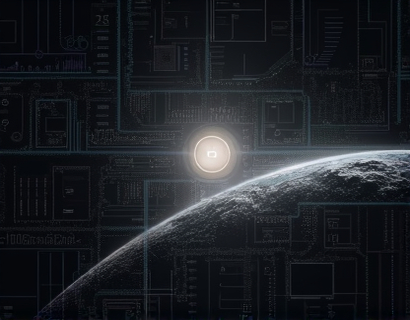Decentralized Innovation: Empowering Global Blockchain Collaboration and Ecosystem Growth Through Comprehensive Platforms
The advent of blockchain technology has ushered in a new era of decentralization, offering unprecedented opportunities for innovation and collaboration across various industries. At the heart of this revolution is the need for comprehensive platforms that can enhance the efficiency, scalability, and governance of decentralized networks. This article delves into the concept of a groundbreaking platform designed to revolutionize decentralized networks by fostering global collaboration and ecosystem growth.
In the realm of blockchain, decentralization is not just a technical feature but a philosophical shift towards a more democratic and inclusive approach to technology. However, the complexity and fragmentation of decentralized networks pose significant challenges to collaboration and innovation. Traditional blockchain projects often struggle with fragmented communities, siloed development efforts, and inefficient governance mechanisms. To address these issues, a comprehensive platform is essential, one that can bring together developers, users, and stakeholders from around the world to work cohesively towards common goals.
The proposed platform aims to create a unified ecosystem where blockchain enthusiasts and innovators can connect, share resources, and participate in decision-making processes. By providing a robust and user-friendly environment, the platform seeks to empower individuals and organizations to contribute meaningfully to the growth and development of decentralized networks. This ecosystem is designed to be scalable, ensuring that it can accommodate the evolving needs of the blockchain community as it grows.
Enhancing Collaboration
One of the primary functions of the platform is to enhance collaboration among decentralized network participants. Collaboration is crucial for the success of blockchain projects, as it fosters the exchange of ideas, accelerates problem-solving, and drives innovation. The platform achieves this through several key features:
- Community Forums: Dedicated spaces for discussions on various topics related to blockchain technology, from technical developments to business strategies. These forums allow users to ask questions, share knowledge, and collaborate on projects in real-time.
- Project Collaboration Tools: Integrated tools that facilitate joint development efforts, including version control systems, task management, and code review platforms. These tools ensure that multiple developers can work on the same project seamlessly, maintaining code quality and project momentum.
- Resource Sharing Library: A comprehensive repository of blockchain-related resources, including documentation, tutorials, and open-source code. This library serves as a one-stop-shop for users looking to learn or implement new blockchain solutions.
By providing these collaborative tools, the platform breaks down barriers to entry and encourages a culture of open cooperation. Users can easily find and engage with like-minded individuals, leading to more innovative and effective solutions.
Fostering Innovation
Innovation is the lifeblood of the blockchain ecosystem, and the platform is designed to nurture and support new ideas and technologies. To achieve this, the platform offers the following features:
- Idea Incubator: A dedicated space where users can propose and develop new blockchain projects or improvements to existing ones. The incubator provides guidance, mentorship, and resources to help ideas grow from conceptual stages to viable projects.
- Hackathons and Challenges: Regular events that bring together developers and innovators to solve specific blockchain-related problems. These events not only stimulate creativity but also foster a sense of community and competition, driving rapid innovation.
- Research and Development Hub: A section focused on cutting-edge research in blockchain technology. This hub features articles, white papers, and case studies that keep users informed about the latest advancements and trends in the field.
These features create an environment that encourages experimentation and risk-taking, essential components of innovation. By supporting new ideas and providing the necessary resources, the platform helps to push the boundaries of what is possible with blockchain technology.
Improving Governance
Effective governance is critical for the long-term success and sustainability of decentralized networks. The platform addresses governance challenges by implementing transparent and inclusive decision-making processes. Key governance features include:
- Decentralized Autonomous Organization (DAO) Integration: The platform is built on a DAO framework, allowing for decentralized and community-driven governance. Token holders can propose and vote on proposals, ensuring that decisions reflect the collective will of the community.
- Transparent Reporting: Regular and detailed reports on the platform's activities, financials, and project progress are made available to all users. This transparency builds trust and accountability within the community.
- Moderation and Conflict Resolution: A clear set of guidelines and a dedicated moderation team ensure that discussions remain constructive and that conflicts are resolved fairly. This helps maintain a positive and productive community environment.
By integrating these governance mechanisms, the platform ensures that all participants have a voice in shaping the future of the ecosystem. This democratic approach not only enhances user satisfaction but also leads to more robust and well-considered decisions.
Scalability and Efficiency
As the blockchain ecosystem continues to grow, scalability and efficiency become increasingly important. The platform is designed with these factors in mind, incorporating advanced technologies and best practices to ensure seamless performance:
- Modular Architecture: The platform is built using a modular architecture, allowing for easy updates and the addition of new features without disrupting existing functionalities. This design ensures that the platform can evolve alongside the needs of the community.
- Optimized Network Infrastructure: Utilizing state-of-the-art network infrastructure, the platform ensures low latency and high throughput, even as the user base expands. This is crucial for maintaining a smooth and responsive user experience.
- Energy Efficiency: Recognizing the environmental impact of blockchain technology, the platform employs energy-efficient consensus mechanisms and data center practices. This commitment to sustainability aligns with the values of the global blockchain community.
By focusing on scalability and efficiency, the platform can support a large and growing user base without compromising performance. This ensures that the ecosystem remains accessible and beneficial to all participants, regardless of their size or resources.
Conclusion
The proposed platform represents a significant step forward in the evolution of decentralized networks. By enhancing collaboration, fostering innovation, and improving governance, it addresses the key challenges facing the blockchain community today. The platform's comprehensive features and commitment to transparency and inclusivity make it an invaluable resource for blockchain enthusiasts and innovators worldwide. As the ecosystem continues to grow and mature, such platforms will play a crucial role in driving efficiency, scalability, and collective success.











































